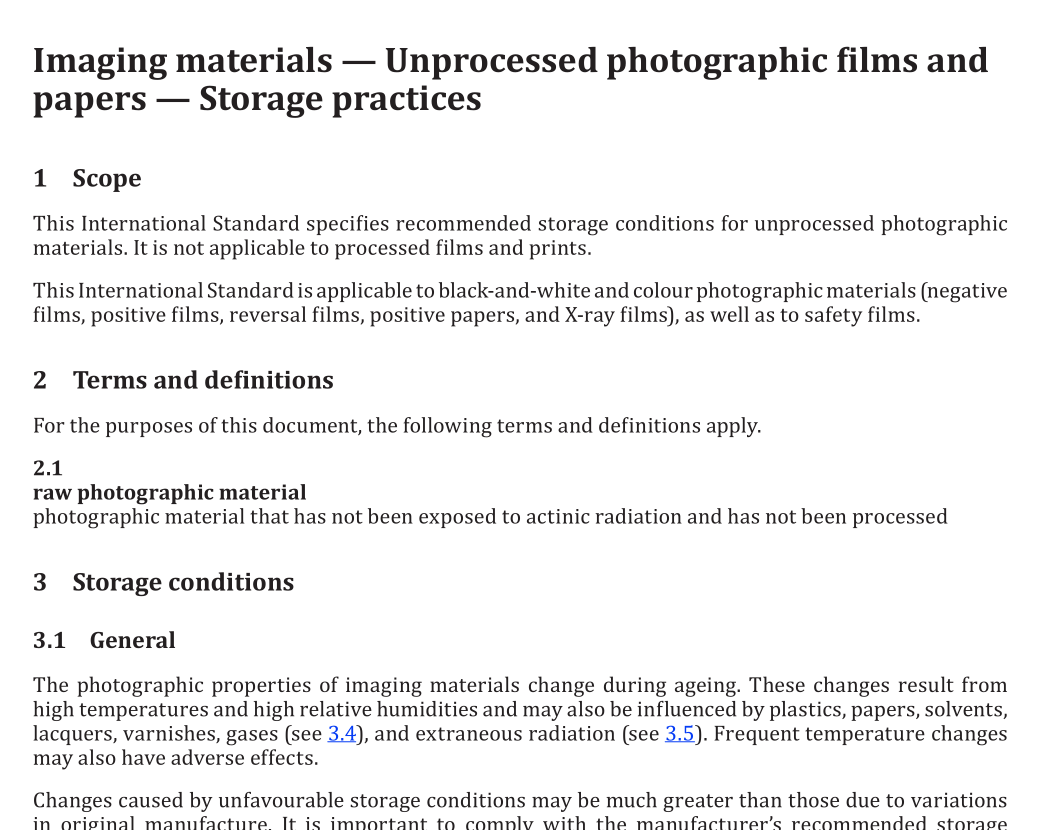ISO 18928 pdf download

ISO 18928 pdf download Imaging materials — Unprocessed photographic films and papers — Storage practices
This International Standard specifies recommended storage conditions for unprocessed photographicmaterials. It is not applicable to processed films and prints.
This International Standard is applicable to black-and-white and colour photographic materials (negativeilms, positive films, reversal films, positive papers, and X-ray films), as well as to safety films.
2 Terms and definitions
For the purposes ofthis document, the following terms and definitions apply2.1raw photographic materialphotographic material that has not been exposed to actinic radiation and has not been processed
3 Storage conditions
3.1General
The photographic properties of imaging materials change during ageing. These changes result fromhigh temperatures and high relative humidities and may also be influenced by plastics, papers, solventslacquers, varnishes, gases (see 3,4 ), and extraneous radiation (see 3.5). Frequent temperature changesmay also have adverse effects.
Changes caused by unfavourable storage conditions may be much greater than those due to variationsin original manufacture. lt is important to comply with the manufacturer’s recommended storageconditions and, where given, to an expiration date.
Films and papers should be exposed and processed as soon as possible after the original package hasbeen opened.Opened packages should be resealed under recommended conditions for further storage
3.2 Relative humidity
Photographic material should generally be kept in equilibrium with 40 % to 60 % relative humidity(RH) Containers shall be kept sealed until the material is used.
Films and papers are not usually stored for long periods between exposing and processingProduction schedules, customer needs, latent image fading or growth, etc, are important factorshere. Furthermore, vesicular, diazo, thermally processed silver, and electrographic type materials arenormally processed immediately.
If conventional sheet films or papers are not to be processed immediately, they may be stored incommercially available light-tight “paper safes” or in the manufacturer’s original container.
The relative humidity ofthe storage area shall be maintained below 65 % because higher humidities candamage containers (e.g. rust), cause labels, tapes and cartons to deteriorate, and encourage the growthof fungi. lt can also induce adhesion (blocking) between adjacent laps or layers.
Humidities below 30 % can make film and paper temporarily brittle and lead to unacceptable curl andpossible emulsion cracking.
3.3 Temperature
Recommended temperatures during storage depend on the kind of photographic material and on the duration of storage. General guidelines are given in Table 1. In all cases, the information provided by the manufacturer shall be followed.
When storing for less than a month, photographic materials may be kept at approximately 25 °C. Most manufacturers recommend a maximum temperature of 13 °C for longer periods. Manufacturers’ expiration dates can be extended by storing at still lower temperatures. Note that infrared-sensitive films shall be stored at –18 °C.
If films or papers are to be kept for several days or more between exposing and processing, many of the considerations in Clause 3 apply. Storage temperatures should be the same for exposed as for unexposed material.









